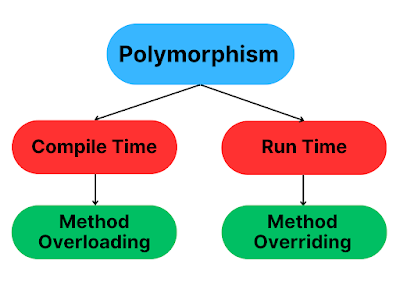Polymorphism is a fundamental concept in object-oriented programming (OOP) that allows us to perform a single action in different ways. In Java, polymorphism is achieved through two main mechanisms: method overloading (compile-time polymorphism) and method overriding (runtime polymorphism).
1. Compile-Time Polymorphism (Static Polymorphism):
Compile-time polymorphism in Java is achieved through method overloading. Method overloading allows you to define multiple methods with the same name but with a different number of parameters or different types of parameters. The correct method will be determined by the argument list at compile time.
Example of function overloading:
class Main
{
static int add(int a, int b)
{
return a + b;
}
static double add(double a, double b)
{
return a + b;
}
public static void main(String[] args)
{
System.out.println(add(2, 3)); // Output: 5
System.out.println(add(2.0, 3.0)); // Output: 5.0
}
}
In this example, the `add` method is overloaded to handle both integer and floating-point arguments. The appropriate version of the method is selected based on the argument types at compile time.
2. Runtime Polymorphism (Dynamic Polymorphism):
Runtime polymorphism in Java is achieved through method overriding and the use of an interface or a superclass reference to refer to subclass objects.
Example of method overriding:
class Animal
{
void makeSound()
{
System.out.println("The animal makes a sound");
}
}
class Cat extends Animal
{
void makeSound()
{
System.out.println("The cat meows");
}
}
class Dog extends Animal
{
void makeSound()
{
System.out.println("The dog barks");
}
}
class Main
{
public static void main(String[] args)
{
Animal myAnimal = new Animal();
Animal myCat = new Cat();
Animal myDog = new Dog();
myAnimal.makeSound(); // Output: The animal makes a sound
myCat.makeSound(); // Output: The cat meows
myDog.makeSound(); // Output: The dog barks
}
}
In this example, we have a super class `Animal` and two sub classes `Dog` and `Cat`. Each sub class overrides the `makeSound()` method of the super class. When the method is called, the JVM checks the type of the object the method is called upon and executes the appropriate method.





